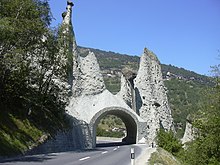Euseigne earth pyramids

The pyramids of Euseigne are one of the most famous natural monuments of the Eringer valley and the Valais . The earth pyramids form one of the most important geological sights in the Alps and are under the protection of the Swiss Confederation.
location
The earth pyramids are located in the Val d'Hérémence and are cut through by a short tunnel arch from the road that leads up from this valley. The road continues to the village of Euseigne in Val d'Hérens.
requirement
In the final phase of the last Ice Age ( Würme Ice Age ), around 80,000 to 10,000 years ago, the Eringer Glacier (Glacier d'Hérens) receded to the south. When it continued to melt, two glacier tongues remained in what is now the upper valley of the Borgne torrents and the valley of the Dixence .
When the ice retreated, these two side glaciers left behind huge amounts of debris dragged along by their lateral moraines .
In what is now the Dixence estuary near Euseigne, this glacier debris of various origins was pushed together to form a mighty central moraine that also contains large boulders. The moraines were compressed at this point with enormous pressure by ice masses over 1000 m thick and dried up after the ice had melted. This created cavities between the boulders and stones, which gradually filled with fine-grained material ( clay and sand ). An extremely hard and cemented mixture formed, which is known as a concrete moraine .
Emergence
Since the retreat of the ice, the deposited moraine material has been exposed to the weather, which slowly but steadily wears down this rather waterproof, heterogeneous, hard concrete. Precipitation and meltwater, which trickles over the surface of the moraine, gradually expose the large, resistant boulders. Thanks to their size and considerable weight, these chunks form “protective caps” ( chapeau protecteur ). They compress the underlying material and protect it from being eroded by wind and water. The unprotected moraine all around, on the other hand, crumbles and is gradually swept away by wind and water, or respectively ground away and blown away. This natural process of erosion is still going on. The Euseigne pyramids are 10 to 15 meters high. Their stone protective caps on pillars consist of massive boulders several meters in diameter and up to 20 tons in weight. It is either gneiss (granite slate) or dark green rock ( serpentinite ) that was carried down by the ice age ice flow from the ends of the Eringer valley or the Val d'Hérémence .
Another process
The pyramids of Euseigne were created through lengthy, natural geological processes and are inevitably heading towards natural decay. Sooner or later they will collapse and lose their stone caps and then disappear within several decades or centuries. The crumbling of the "concrete moraine" is accelerated by trickle and seepage water, as well as by temperature weathering , which widen the crevices inside these structures. This will make your foundation brittle. The stone heads sway and tumble down. The then bareheaded pyramids are more exposed to the weather and are not able to withstand it permanently. In Euseigne, some of the peaks of the pyramids are already "beheaded".
swell
- Pierre Kunz, Department of Earth Sciences, University of Geneva . In collaboration with EOS, Municipality of Hérémence. Evolène'Art
Web links
Individual evidence
- ^ Federal inventory of the landscapes and natural monuments of national importance to be preserved, object no. 1708 on admin.ch
Coordinates: 46 ° 10 ′ 25 " N , 7 ° 25 ′ 2" E ; CH1903: five hundred ninety-eight thousand three hundred thirty-nine / 113559
